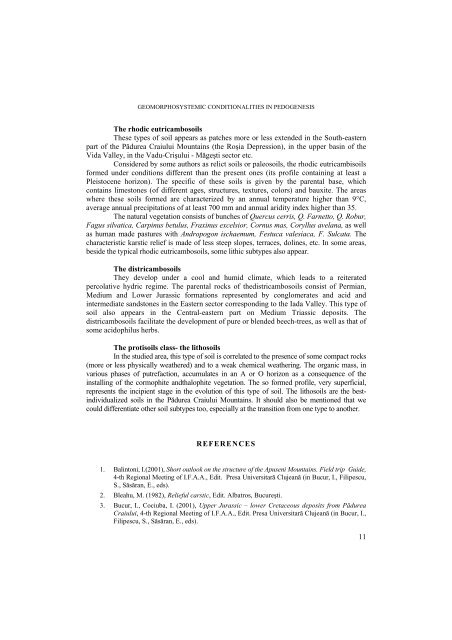studia universitatis babeÅ â bolyai geographia 1
studia universitatis babeÅ â bolyai geographia 1
studia universitatis babeÅ â bolyai geographia 1
You also want an ePaper? Increase the reach of your titles
YUMPU automatically turns print PDFs into web optimized ePapers that Google loves.
GEOMORPHOSYSTEMIC CONDITIONALITIES IN PEDOGENESIS<br />
The rhodic eutricambosoils<br />
These types of soil appears as patches more or less extended in the South-eastern<br />
part of the Pădurea Craiului Mountains (the Roşia Depression), in the upper basin of the<br />
Vida Valley, in the Vadu-Crişului - Măgeşti sector etc.<br />
Considered by some authors as relict soils or paleosoils, the rhodic eutricambisoils<br />
formed under conditions different than the present ones (its profile containing at least a<br />
Pleistocene horizon). The specific of these soils is given by the parental base, which<br />
contains limestones (of different ages, structures, textures, colors) and bauxite. The areas<br />
where these soils formed are characterized by an annual temperature higher than 9°C,<br />
average annual precipitations of at least 700 mm and annual aridity index higher than 35.<br />
The natural vegetation consists of bunches of Quercus cerris, Q. Farnetto, Q. Robur,<br />
Fagus silvatica, Carpinus betulus, Fraxinus excelsior, Cornus mas, Coryllus avelana, as well<br />
as human made pastures with Andropogon ischaemum, Festuca valesiaca, F. Sulcata. The<br />
characteristic karstic relief is made of less steep slopes, terraces, dolines, etc. In some areas,<br />
beside the typical rhodic eutricambosoils, some lithic subtypes also appear.<br />
The districambosoils<br />
They develop under a cool and humid climate, which leads to a reiterated<br />
percolative hydric regime. The parental rocks of thedistricambosoils consist of Permian,<br />
Medium and Lower Jurassic formations represented by conglomerates and acid and<br />
intermediate sandstones in the Eastern sector corresponding to the Iada Valley. This type of<br />
soil also appears in the Central-eastern part on Medium Triassic deposits. The<br />
districambosoils facilitate the development of pure or blended beech-trees, as well as that of<br />
some acidophilus herbs.<br />
The protisoils class- the lithosoils<br />
In the studied area, this type of soil is correlated to the presence of some compact rocks<br />
(more or less physically weathered) and to a weak chemical weathering. The organic mass, in<br />
various phases of putrefaction, accumulates in an A or O horizon as a consequence of the<br />
installing of the cormophite andthalophite vegetation. The so formed profile, very superficial,<br />
represents the incipient stage in the evolution of this type of soil. The lithosoils are the bestindividualized<br />
soils in the Pădurea Craiului Mountains. It should also be mentioned that we<br />
could differentiate other soil subtypes too, especially at the transition from one type to another.<br />
REFERENCES<br />
1. Balintoni, I.(2001), Short outlook on the structure of the Apuseni Mountains. Field trip Guide,<br />
4-th Regional Meeting of I.F.A.A., Edit. Presa Universitară Clujeană (in Bucur, I., Filipescu,<br />
S., Săsăran, E., eds).<br />
2. Bleahu, M. (1982), Relieful carstic, Edit. Albatros, Bucureşti.<br />
3. Bucur, I., Cociuba, I. (2001), Upper Jurassic – lower Cretaceous deposits from Pădurea<br />
Craiului, 4-th Regional Meeting of I.F.A.A., Edit. Presa Universitară Clujeană (in Bucur, I.,<br />
Filipescu, S., Săsăran, E., eds).<br />
11
















